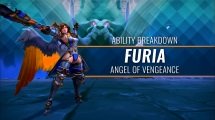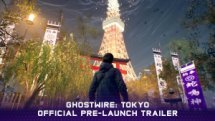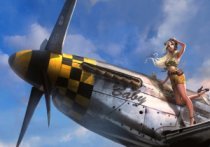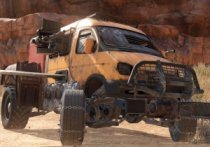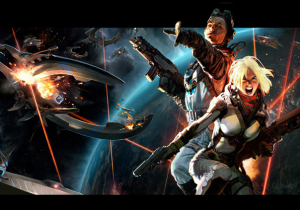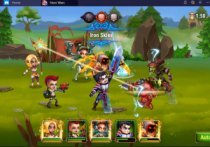Attack on Titan: Wings of Freedom Review

Co-Written by Jason Parker (Ragachak)
The eternal wait for the next season of the Attack on Titan Anime may carry on, but the love letter that its fans have been waiting for has arrived. Attack on Titan: Wings of Freedom brings the reality of the anime straight to your face, with adrenaline pumping gameplay, by the book storytelling, RPG progression systems you never expected, spot on Japanese voice acting, and even the Holy Grail: multiplayer! With summer coming to a close, its time to bring the heat to your Playstation 4 or PC one more time. Here’s Ragachak’s and my thoughts on this under-hyped gem that will appeal to fans and non-fans alike!
Game Modes
Attack on Titan brings two main ways to play, interconnected with each other through a basic progression system. Story Mode is where it’s at for new players wanting to get tutorialized into the unusual challenging controls of Attack on Titan. Now I’m a little split on the presentation of this.
The story is presented well, albeit in Spark Notes fashion. The key points of the story, for the most part, are touched on, but everything is brief and rushed. If you are already a fan of the manga or anime, it’s not such a big deal. Just the reminder of the raw Feels of either is enough for you to get back into the mindset of the characters. However if you’re new like my co-writer, Ragachak, you might miss some of the subtlety, attachment to characters, or sudden jumps in storytelling. That brings me to my next point on Story Mode…
Some of the key points of the story are told via dialogue during the actual missions. As I’ll touch on below, shit gets real in these missions. If you have time to watch your radar and read dialogue, chances are people around you are dying. Which brings me to my final point on story mode.
You don’t eat Ian on my watch, asshole!
The real reason why I feel Story Mode is best enjoyed by players who have already experienced the full glory of the anime or manga, is story mode puts the power in your hands to make a difference. After spending hours watching helplessly behind your monitor as the memorable cast dies one by one, now you can make a difference. Not really! But the illusion is there. You are the savior of humanity. The lives of your comrades rests on you! And with the high skill cap the game offers, when comparing a terrible run with an S rank run, you feel like you have made a distinguishing difference in the outcome of the war.
Riding a horse is vital, of course.
Expedition Mode, on the other hand, thrusts you into the horrors of the Scout regiment for what I can best compare to the co-op missions in Dragon Ball Xenoverse. And, just like said co-op missions, this is where you can team up with friends to showcase your buffed up characters and mad skills in action. I’ll let Jason say more on that.
I do recommend looking closely at the Expedition Mode. I spent more time on it than I did the Story Mode. You can play it offline or online, and either way, it’s a more fictional version, where you complete missions of varying degrees of difficulty and style. You might be scouting, or just slaughtering or any number of things. The reason this is important? Levels, skills, and equipment carry over between the two modes! Expedition Mode also has an option to keep battling through stages without rest for greater rewards if you succeed [similar to a mode in DW 7: Empires]. I haven’t played with that much, I stuck to the regular expeditions and exploring the world as a variety of the cast [but it boiled down to Levi and Mikasa being the best for everything]. Back to Dizzy to break down the gameplay.
Gameplay
So how does the omni-directional gear pan out into game controls? Well I should first warn you to get yourself a gamepad if you’re playing on PC. The sheer number of buttons you need to make grand plays happen swiftly is a nightmare on a keyboard and mouse set-up, even with the fully customizable button mapping. Gamepads however feel just right.
I make this look easy. Don’t mistake this for being easy.
Players are capable of running across the ground or using their ODG to maneuver. When grappling your surroundings, the cables target automatically. That’s not to say movement in this game is easy mode. Knowing what your cables will grapple, how long to hold the grapple before the next grapple, and when to boost to bridge gaps between good grappling spots will make the difference between flopping around like a Magikarp or making Spiderman look bronze tier. This becomes even more obvious when buildings around you are crumbling down, or you’re stuck out in the fields on horseback with very limited high altitude grapple points. There’s few things scarier in this game like flipping yourself over your next grapple point, and knowing you are falling straight down to the floor… with potential titans nearby waiting to capitalize.
To run out of both swords and gas on a mission is to know true terror.
Combat with the titans themselves becomes even more intense. Players quickly learn that hesitation and intimidation are the double devils on your shoulder leading you to death. You must embrace your inner Sonic to go fast if you want to slice and dice titans like a pro. Jason actually preferred a slow and steady process which can work fine, but here’s the downside to it. The titan AI is pretty dumb, which honestly fits with the show so I can’t fault them, but its non-existent if you arrive and slice titans down in an instant. The red markers for titans on the radar will turn into a giant eyeball once a Titan recognizes your presence, and believe me it gets unnerving when they are staring straight at you with their cold merciless façade. Daring you to dive in. And, perhaps most importantly, forcing you to waste gas boosting around them to find an opening.
I got cocky and learned a valuable lesson for it. You might not be so lucky.
Utilizing a lock on toggle function, you can target and grapple titans’ knees, elbows, or neckline. However, depending on the size of the titan, as well as the length of your grapple, you sometimes can’t go straight for the neck kill without climbing your way up their body. What’s more, boss and abnormal type titans will flip around, break buildings, and move irregularly to put strain on your ODG to break free. This can happen without warning and send you hurtling straight to the ground if done while you’re boosting in the wrong direction, leaving you incredibly vulnerable for counter-attacks! If this happens against one of the real bosses of the game such as the infamous female titan, a simple mistake like that can be game over.
Finally there is the Titan mode missions where you play as the mysterious rogue titan. If anyone grew up loving Rampage in its various forms form arcade to Playstation 2, these titan levels feel like the fully realized 3D version of that gameplay. Nearly the entire world is a destructible environment, gameplay has just the right amount of clunkiness to make it challenging while feeling natural. Plus that Titan gets you right in that One Punch Man mode as you feel like a juggernaut smashing through the same monsters that gave you hell with your ODG. With dodging, jumping, throws, power smashes, and charge hits to mix it up, these missions are essentially the best possible ‘mini-game’ levels to shake up the normal gameplay from becoming stale. Plus they are a bit less hectic and let you enjoy the surrounding dialogue that you are normally in too much of an adrenaline fog to enjoy.
Progression and Performance
Attack on Titan has a strange system in place for progression. Each mission ranks your performance and rewards you accordingly. Mess up one too many attack formations? That will cost you. Take your time hiding in the shadows while your allies handle the brunt of the enemy? Cost you. Get your face slammed in the pavement? Oh that’ll cost you. And it all ends up cumulative over time, as lesser players will find themselves working with weaker and weaker combatants as the story progresses. If you perform like a juggernaut though, you get more currency, new character skills, and better materials to upgrade your gear. Essentially making the game easier for those will the power to best use the game’s existing systems.
In a way it’s an ironic call to the story of Attack on Titan in which the best recruits are given the best gear, and kept safe within the inner-most city walls while the under performers are sent out into the fields as Scouts to die a hopeless death with underfunded equipment. Though if you ever find the world too harsh, you can take a break and join that exact Scout regiment to power level your gear and characters, as progression in one transfers over to the other.
Visuals
Attack on Titan uses a cell-shaded visual style that turns the characters of the anime into 3D balloons of themselves. It works tremendously well, especially when bringing out the wonky personalities of the titans themselves. Cutscenes feel insanely good, and even though some of the magic of the anime is lost to them, the characters still offer a tour de force of emotion and animation needed to get the point across. As Jason told me, it isn’t enough to make you a fan of the show if you weren’t going in, but it’s enough to get fans of the show pumped up for each successive mission.
While the stages themselves can be a bit cookie cutter, visually they immerse you into the world of Attack on Titan. Right out of the gates, your time in Trost District will give you flash backs to the anime. Honestly the game is only lacking more civilians being caught in the crossfire to create a perfect 1:1 experience. The Garrison Guard stationed on cannons, the city slowly being smashed to bits, and the sparse but constantly active fellow soldiers flying around in a dazzling synchronized array of death will leave you blown away for the first few hours. Also the option for turning off vore is an interesting addition, but if you are immersing yourself in this world and not able to handle the horrors of it, Attack on Titan probably isn’t for you in the first place.
Critique
Attack on Titan has some short-comings, and a few areas that will simply be matters of taste. If you like your beat-em-ups mindless, Attack on Titan might have 1 too many tactical elements to meet your needs. Especially on the higher difficulty modes, you will go through blade durability and gas canisters incredibly fast. This forces you to make tactical retreats from time to time to refill your supplies, breaking the action. True fans of the series will respect having to do this, and it makes you play more carefully when you know supplies are severely limited. But it certainly won’t appeal to everyone.
Again the story might be too limited if you haven’t familiarized yourself in it. Some of the decisions of characters will seem asinine or hasty without the full context known. Jumps in story take away from key character development that makes the show so impactful. Though if you can keep up with in-game dialogue, and take the time to communicate with NPCs between missions, you will see the story tellers did the best they could given the limited time they are given to tell you the story.
You ate Ian! I’ll make you pay!
Finally the progression is a strange balance, making the game easier for pro players. Part of the appeal of Attack on Titan is feeling helpless against an impossible unfeeling foe. Yet the more you slash those foes down before you like they’re nothing, the easier it becomes to do so in later levels. Sure it keeps the adrenaline rush pumping for someone who took to this game like a duck to water, but it leaves me wanting a real challenge. Hard mode is the only answer for those wanting this challenge. Unfortunately I haven’t progressed to the ends of story mode at the time of this review, or dabbled with hard mode enough to see if that is a solid answer to the critique.
While I’m a firm believer in subbing over dubbing, I will say I wish English voice overs were an option. Having to read key dialogue during the stress of missions is a bit much, and I usually found myself deciding between stopping to read dialogue or ignoring it to continue an S-rank worthy rampage. Getting these vital updates audibly would have been a huge step-up for my enjoyment, assuming the dub was of any reliable quality.
Conclusion: Excellent (5/5)
Despite some key flaws that might off-set either hardcore fans, or adrenaline junkies considering jumping into Attack on Titan fresh, the overall presentation for Wings of Freedom should blow away all expectations. The visceral rush of getting kicked into a collapsing building, or slamming your swords helplessly against a Titan’s grip will bring the world of Attack on Titan to life in ways being a third person viewer of the manga or anime just can’t. I can only play the game in 2-3 mission spurts as my nerves are shot, my eyes go bloodshot from forgetting to blink, and I need a change of shirt as one bad subjugation attempt can leave me sweaty and wrists shaking. But through all the stress, the hard to master but extremely rewarding controls shine through.
The sound is true to the source material, as is the Japanese voice acting. The visuals are a true love letter to Attack on Titan fans and run at incredibly smooth frame rates even on a three generation old laptop graphics card. If you ever found Spiderman games enjoyable as a kid, or just want to face your own mortality for an intense shot of adrenaline, then Attack on Titan is the must have action tactics game this summer. The last minute addition of co-op multiplayer really seals the deal. Why are you still here?! Go throw your money at Koei already! We need more games like this to shake up the world of low quality anime games out there.
Addendum: It should be noted that the game difficulty spikes toward the end of Chapter 1. Around that same time, you can begin to replay previous missions to earn experience and progress if it’s too hard.
Articles You May Enjoy
- Fractured Reveals Alpha Test 2 Date and Crowdfunding Update
- Fractured, an upcoming MMO released a few bits of big news recently - the first is the status of Alpha 1 Test 2.
- Fall Schematic Mobile RPG Redefines "Free To Play"
- Fall Schematic by Drawn by Clouds is an upcoming card game that opens up a new business model while staying free to play.




